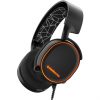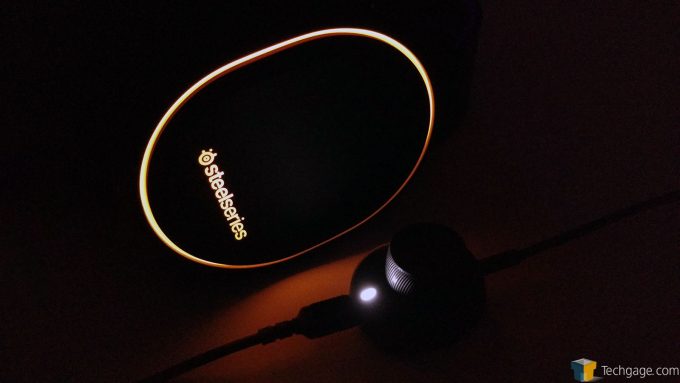- Qualcomm Launches Snapdragon 4 Gen 2 Mobile Platform
- AMD Launches Ryzen PRO 7000 Series Mobile & Desktop Platform
- Intel Launches Sleek Single-Slot Arc Pro A60 Workstation Graphics Card
- NVIDIA Announces Latest Ada Lovelace Additions: GeForce RTX 4060 Ti & RTX 4060
- Maxon Redshift With AMD Radeon GPU Rendering Support Now Available
SteelSeries Arctis 5 7.1 Surround Sound RGB Headset Review

After 2 years we’re back looking at another headset from SteelSeries. Where the last one occupied the premium end of the scale with a price tag to match, the new Arctis series is set to take aim at the mainstream market, but retain the premium features. Read on to see how the Arctis 5 stacks up.
Page 2 – SteelSeries Arctis 5 Testing
Testing headsets can be tricky, so we’ve decided to approach it a bit differently this time around by running the Arctis 5 through the tests over at audiocheck.net, to give us some data using more standardized testing, before we talk about our personal experiences based on ease of use, and how the headset performs while playing games, watching movies, and listening to music.
We also performed a comparison test of the new Clearcast microphone, before wrapping things up with a quick look at whether or not the Arctis headset is comfortable enough to allow gamers to hunker down for hours without having to worry about fatigue or making adjustments.
Before we go any further it should be said that while it is nice to have some actual tests to run the headset through, the results will ultimately be affected by my hearing. I’d like to consider my hearing to be healthy despite some of the crazier things I’ve done in my younger days.
Even so, I have regular hearing tests every 2 years that have been coming back clear, and always protect my ears if I’m playing with a band or attending a loud event, but that doesn’t mean that my ears will hear the same sounds as the next person since everyone’s ears are tuned differently.
The results below show how the Arctis 5 stacked up to a top-tier headset that I have been using for several years, the SteelSeries H-Wireless. Although it’s no longer available, having been updated and relaunched as the Siberia 840, it has the same size and type of drivers as the Arctis series, so we figured it would be worthwhile it to include some comparison data, especially given the much higher price point of the wireless version.
In an effort to keep this review as streamlined as possible, we didn’t go into detail about each test and what it represents, however those looking for more information can head over to the website for a full explanation. All tests were run with the EQ flat without any other options enabled unless specifically mentioned.
| Arctis 5 | H-Wireless | |
| Bass Response | 20Hz | 20Hz |
| Treble Response | 14kHz | 16kHz |
| Spectral Flatness | Slight dip in the upper range | Slight dip in the upper range |
| Dynamic Range | 66dB below full scale | 66dB below full scale |
| Quality | No rattle or buzz | No rattle or buzz |
| Driver Matching | OK | Slight fluctuation towards right cup at mid to high frequencies |
| Wiring | OK | OK |
| Binural Test | OK | OK |
So what does all of this mean? Well, it means that the Arctis 5 held its own with a headset that retailed for over twice the price.
After putting on the Arctis 5, I immediately mentioned to Rob, our Editor-in-Chief, that it seemed like there wasn’t as much treble. After running these tests, it became clear that this summation was correct as the treble response test stops being audible at a lower frequency than with the H-Wireless.
To me, this gave the headset a perceived bass boost, which may not be preferred by some and will ultimately come down to personal preference, but remember that the EQ is flat and there are tweaks that can be made to bring the treble back in line.
Those who have checked the official specifications for the Arctis 5 might be wondering why the numbers are off. The Arctis 5 is advertised to have a frequency response from 20-20,000Hz, but we found it only went up to 14,000Hz (14kHz), however that’s based on my hearing. While it’s clear that my ears can hear up to at least 16,000Hz as is evident by the treble response testing of the H-Wireless, the numbers are still lower than advertised, but this isn’t likely to an issue for most.
The Quality, Driver Matching, and Wiring tests revealed no issues with the Arctis 5, however it did identify a slight fluctuation with the H-Wireless during the Driver Matching test, but that’s nothing we need to be worried about as far as this review is concerned. In the end, it’s great to find that the Arctis 5 has been solidly designed and built to be consistent across the board.
To test the microphone recording quality we positioned the mic on both headsets so it was exactly at the corner of my mouth, an inch and a half away. Recording levels were the same for both headsets, and once done we put the samples back to back so that they can be easily compared.
After playing back both samples, it became immediately clear that the recording quality of the new Clearcast microphone is head and shoulders beyond what the H-Wireless can produce. Not only is it clearer and less muffled, but the noise-cancelling feature is in full effect as it removed the slight hiss found in the sample recorded using the H-Wireless.
Ease of use again comes down to personal preference. We found the ChatMix control made for easy, on-the-fly adjustments so that voice chat doesn’t get washed away by other sounds, however the control dial is so small and lightweight that it moved around a bit and sometimes flipped onto its side.
The on-ear controls are well laid out and become easily accessible after a while, once muscle memory kicks in. Customizing the lighting, sound, and microphone was simple as well, thanks to the easy layout of the Engine 3 software. This was made even easier by the small “?” in the corner of each section, in case the purpose of the tweak is unclear.
Support our efforts! With ad revenue at an all-time low for written websites, we're relying more than ever on reader support to help us continue putting so much effort into this type of content. You can support us by becoming a Patron, or by using our Amazon shopping affiliate links listed through our articles. Thanks for your support!





